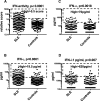High levels of circulating interferons type I, type II and type III associate with distinct clinical features of active systemic lupus erythematosus
- PMID: 31036046
- PMCID: PMC6489203
- DOI: 10.1186/s13075-019-1878-y
High levels of circulating interferons type I, type II and type III associate with distinct clinical features of active systemic lupus erythematosus
Abstract
Background and aim: Interferons (IFNs) are considered to be key molecules in the pathogenesis of systemic lupus erythematosus (SLE). We measured levels of type I, II and III IFNs in a large cohort of patients with systemic lupus erythematosus (SLE) and controls and explored associations among high levels of different IFN types and distinct SLE features.
Methods: Four hundred ninety-seven well-characterized SLE patients and 322 population controls were included. Disease activity was assessed by SLE Disease Activity Index (SLEDAI) and Systemic Lupus Activity Measure (SLAM). Functional type I IFN activity was estimated by a WISH reporter cell assay. Levels of IFN-γ were estimated by MSD 30-plex assay. IFN-α and IFN-λ1 were measured by ELISA. Values above the third quartile of patients' measurements were defined as high. Associations among high IFN results and SLE features were investigated by nominal regression analysis.
Results: All IFN measurements were higher in SLE patients than in controls. High type I IFN activity correlated with levels of IFN-γ and IFN-α and associated with active SLE in most domains: weight loss, fatigue, fever, rash, lymphadenopathy, arthritis, nephritis and haematological manifestations. Specific SLE subsets were linked to the upregulation of different subtypes of circulating IFNs: high IFN-γ to arthritis, nephritis and anti-Ro60 antibodies and high IFN-α to mucocutaneous engagement and anti-Ro52 and anti-La antibodies. Isolated high IFN-λ1 was coupled to anti-nucleosome antibodies and less severe SLE.
Conclusions: High functional type I IFN activity captures active SLE in most domains, but more distinct patterns of organ involvement are associated with profiles of circulating IFNs. High IFN-γ as well as high functional type I IFN activity is a characteristic of severe SLE with nephritis and arthritis, while elevated levels of IFN-α associate with active mucocutaneous inflammation and a more benign cardiovascular profile. IFN-λ1 in isolation is associated with milder disease. Our findings suggest that IFNs contribute to the heterogeneity of clinical manifestations in SLE, and measuring circulating IFNs could assist in designing clinical trials with therapies targeting IFN pathways.
Keywords: Autoantibodies; Disease activity; Interferons; SLE.
Conflict of interest statement
Ethics approval and consent to participate
The study was approved by Regional Ethical Review Board, Stockholm, Sweden. All participants gave informed written consent. The study was performed in accordance with Declaration of Helsinki.
Consent for publication
Not applicable
Competing interests
SE is an employee at Astra Zeneca. The other authors declare that they have no competing interests.
Publisher’s Note
Springer Nature remains neutral with regard to jurisdictional claims in published maps and institutional affiliations.
Figures



Similar articles
-
IFN-λ1 with Th17 axis cytokines and IFN-α define different subsets in systemic lupus erythematosus (SLE).Arthritis Res Ther. 2017 Jun 15;19(1):139. doi: 10.1186/s13075-017-1344-7. Arthritis Res Ther. 2017. PMID: 28619037 Free PMC article.
-
Interferon-lambda1 induces peripheral blood mononuclear cell-derived chemokines secretion in patients with systemic lupus erythematosus: its correlation with disease activity.Arthritis Res Ther. 2011 Jun 16;13(3):R88. doi: 10.1186/ar3363. Arthritis Res Ther. 2011. PMID: 21679442 Free PMC article.
-
Higher activation of the interferon-gamma signaling pathway in systemic lupus erythematosus patients with a high type I IFN score: relation to disease activity.Clin Rheumatol. 2018 Oct;37(10):2675-2684. doi: 10.1007/s10067-018-4138-7. Epub 2018 May 17. Clin Rheumatol. 2018. PMID: 29774490
-
Signaling Pathways of Type I and Type III Interferons and Targeted Therapies in Systemic Lupus Erythematosus.Cells. 2019 Aug 23;8(9):963. doi: 10.3390/cells8090963. Cells. 2019. PMID: 31450787 Free PMC article. Review.
-
Type I Interferons in Systemic Lupus Erythematosus: A Journey from Bench to Bedside.Int J Mol Sci. 2022 Feb 24;23(5):2505. doi: 10.3390/ijms23052505. Int J Mol Sci. 2022. PMID: 35269647 Free PMC article. Review.
Cited by
-
Differences and similarities in cytokine profiles of macrophage activation syndrome in systemic lupus erythematosus and adult-onset Still's disease.Clin Exp Med. 2023 Nov;23(7):3407-3416. doi: 10.1007/s10238-023-00988-4. Epub 2023 Jan 7. Clin Exp Med. 2023. PMID: 36611087
-
Cytokines as Biomarkers in Systemic Lupus Erythematosus: Value for Diagnosis and Drug Therapy.Int J Mol Sci. 2021 Oct 20;22(21):11327. doi: 10.3390/ijms222111327. Int J Mol Sci. 2021. PMID: 34768756 Free PMC article. Review.
-
Precursors to Systemic Sclerosis and Systemic Lupus Erythematosus: From Undifferentiated Connective Tissue Disease to the Development of Identifiable Connective Tissue Diseases.Front Immunol. 2022 May 5;13:869172. doi: 10.3389/fimmu.2022.869172. eCollection 2022. Front Immunol. 2022. PMID: 35603174 Free PMC article. Review.
-
Low CD4 + T cell count is related to specific anti-nuclear antibodies, IFNα protein positivity and disease activity in systemic lupus erythematosus pregnancy.Arthritis Res Ther. 2024 Mar 9;26(1):65. doi: 10.1186/s13075-024-03301-0. Arthritis Res Ther. 2024. PMID: 38459582 Free PMC article.
-
Optimal Selection of IFN-α-Inducible Genes to Determine Type I Interferon Signature Improves the Diagnosis of Systemic Lupus Erythematosus.Biomedicines. 2023 Mar 12;11(3):864. doi: 10.3390/biomedicines11030864. Biomedicines. 2023. PMID: 36979843 Free PMC article. Review.
References
-
- Machold KP, Smolen JS. Interferon-gamma induced exacerbation of systemic lupus erythematosus. J Rheumatol. 1990;17:831–832. - PubMed
Publication types
MeSH terms
Substances
Grants and funding
LinkOut - more resources
Full Text Sources
Other Literature Sources
Medical

